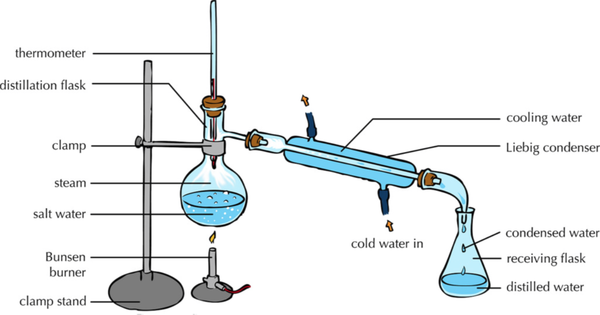Distillation
Contents
Key Stage 3
Meaning
Distillation is a method of separating mixtures that can recover both the solute and the solvent in a solution.
About Distillation
- During distillation the solvent is evaporated away to leave the solute behind, then the solvent is collected and condensed back into a liquid.
| This diagram shows how the solute and solvent can be separated by heating the solution to evaporate the solvent leaving the solute behind and then condensing the evaporated solvent by cooling it down and collecting it in a conical flask. |
Key Stage 4
Meaning
Distillation is a technique used to separate solutes and solvents from solution] that can recover both the solute and the solvent.
About Distillation
Distillation can only be used for:
- Separating a solution to recover both the solutes and solvents from the solutions.
- Separating and recovering insoluble solids from a liquid. However, this is unnecessary as it can be done by filtration.
Distillation cannot be used for:
- Separating two solutes from each other in solution - Chromatography
- Separating an insoluble solid from a soluble solid - Filtration
- Separating two solvents from each other in solution - Fractional Distillation
References
AQA
- Distillation, desalination of sea water, pages 196-7, GCSE Combined Science Trilogy 2, Hodder, AQA
- Distillation, page 137, 138-9, GCSE Combined Science Trilogy 1, Hodder, AQA
- Distillation, pages 103, 164, GCSE Combined Science; The Revision Guide, CGP, AQA
- Distillation, pages 18, 102, GCSE Chemistry; The Revision Guide, CGP, AQA
- Distillation, pages 18, 226, 263, 327-9, GCSE Chemistry; Student Book, Collins, AQA
- Distillation, pages 23-4, GCSE Chemistry, Hodder, AQA
- Distillation, pages 40, 41, 191, 192, 227, GCSE Combined Science Trilogy; Chemistry, CGP, AQA
- Distillation, pages 40, 41, 223,224, 298, GCSE Chemistry, CGP, AQA
- Distillation, pages 9-10, 148-151, 209, GCSE Chemistry; Third Edition, Oxford University Press, AQA
- Distillation; fractional distillation of crude oil, pages 173-4, GCSE Chemistry, Hodder, AQA
- Distillation; fractional, pages 103, 148, GCSE Combined Science; The Revision Guide, CGP, AQA
- Distillation; fractional, pages 19, 230-1, 263, GCSE Chemistry; Student Book, Collins, AQA
- Distillation; of sea water, page 253, GCSE Chemistry, Hodder, AQA
Edexcel
- Distillation, pages 100, 103, 104, 137, GCSE Combined Science; The Revision Guide, CGP, Edexcel
- Distillation, pages 37, 40, 41, 87, 103, GCSE Chemistry; The Revision Guide, CGP, Edexcel
- Distillation; fractional, pages 103, 253, 254, 302, GCSE Chemistry, CGP, Edexcel
- Distillation; fractional, pages 11, 152- 153, GCSE Chemistry, Pearson, Edexcel
- Distillation; fractional, pages 155, 266-267, GCSE Combined Science, Pearson Edexcel
- Distillation; fractional, pages 37, 87, 103, GCSE Chemistry; The Revision Guide, CGP, Edexcel
- Distillation; simple, page 14, GCSE Chemistry, Pearson, Edexcel
- Distillation; simple, page 158, GCSE Combined Science, Pearson Edexcel
- Distillation; simple, pages 102, 106, 111, 113, GCSE Chemistry, CGP, Edexcel
- Distillation; simple, pages 37, 40, 41, GCSE Chemistry; The Revision Guide, CGP, Edexcel
- Distillation; water, pages 10-11, 14, GCSE Chemistry, Pearson, Edexcel
- Distillation; water, pages 139, 154-155, 158, GCSE Combined Science, Pearson Edexcel
